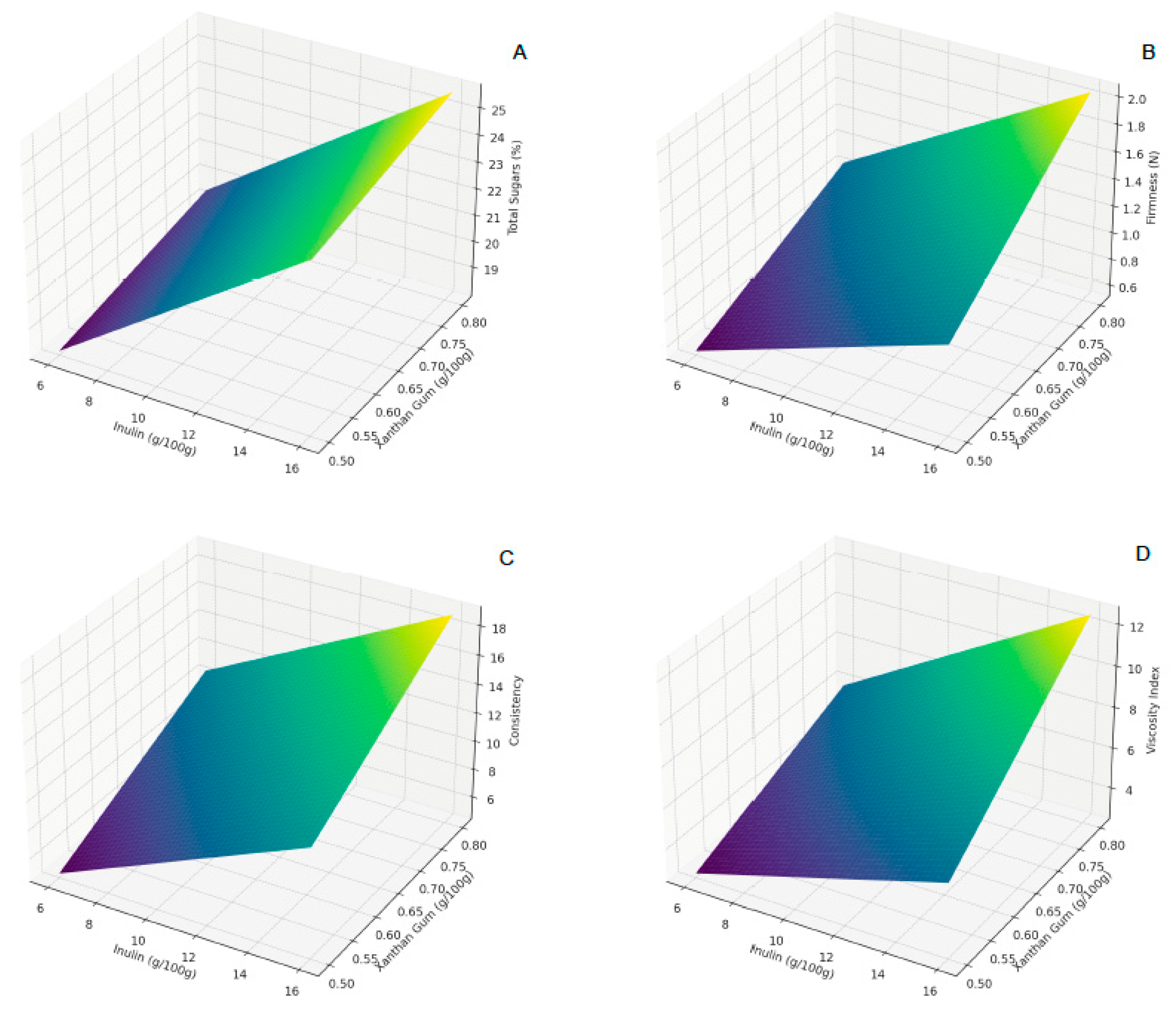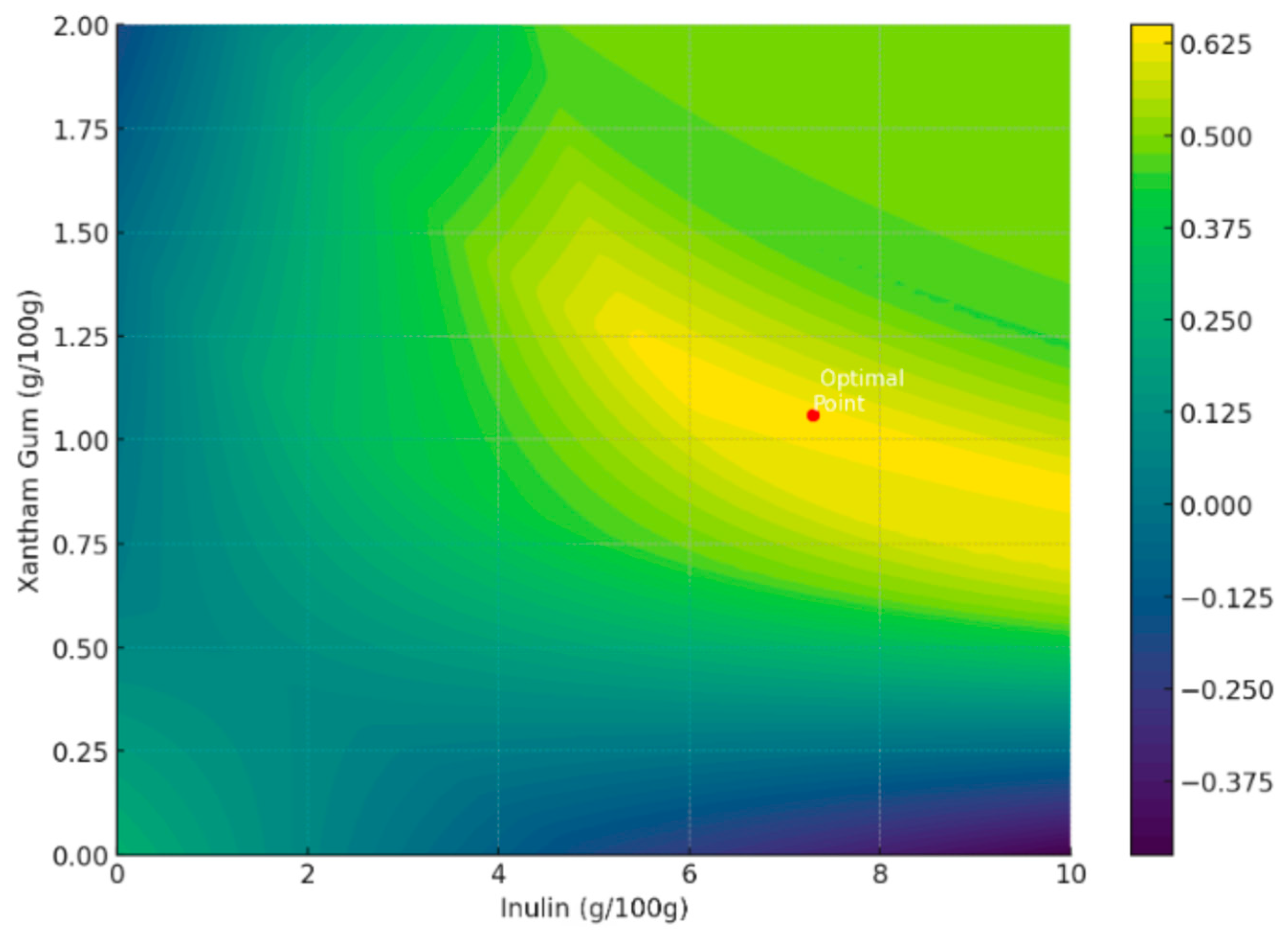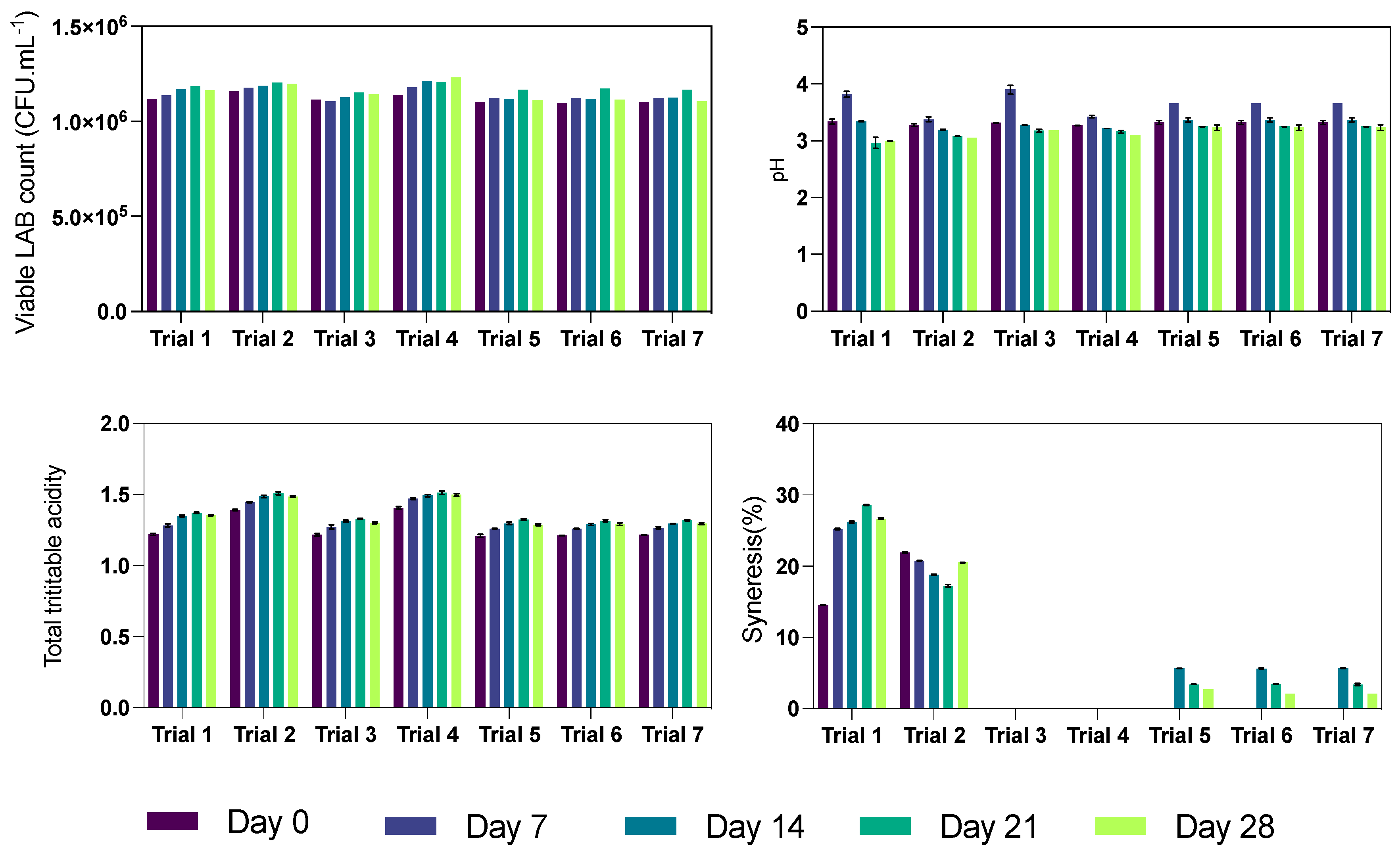Development and Characterization of Symbiotic Buffalo Petit Suisse Cheese Utilizing Whey Retention and Inulin Incorporation
Abstract
:1. Introduction
2. Materials and Methods
2.1. Raw Materials
2.2. Buffalo Milk Skimming and Fermentation
2.3. Production of Buffalo Petit Suisse under a Design of Experiments
2.4. Physicochemical Analyses
2.5. Texture Analysis
2.6. Shelf-Life Study
2.6.1. Determination of Lactic Bacteria Viability
2.6.2. Syneresis determination
2.7. Statistical Analysis
3. Results
3.1. Proximal Composition
3.2. Mechanical Properties
3.3. Optimization of Petit Suisse Formulation
3.4. Petite Suisse Shelf-Life
3.4.1. pH and Titratable Acidity
3.4.2. Viable Lactic Acid Bacteria
3.4.3. Syneresis
4. Conclusions
Supplementary Materials
Author Contributions
Funding
Data Availability Statement
Conflicts of Interest
References
- El Bilali, H.; Strassner, C.; Ben Hassen, T. Sustainable Agri-Food Systems: Environment, Economy, Society, and Policy. Sustainability 2021, 13, 6260. [Google Scholar] [CrossRef]
- Granato, D.; Carocho, M.; Barros, L.; Zabetakis, I.; Mocan, A.; Tsoupras, A.; Cruz, A.G.; Pimentel, T.C. Implementation of Sustainable Development Goals in the dairy sector: Perspectives on the use of agro-industrial side-streams to design functional foods. Trends Food Sci. Technol. 2022, 124, 128–139. [Google Scholar] [CrossRef]
- Godinho, F.M.S.; Krug, M.; Figueiredo, R.P.; Müller, A.; Jank, L.; Tomaszewski, C.A.; Hillesheim, D.R.; Kinast, É.J.; Frazzon, A.P.G.; Motta, A.S. Microbiological and physicochemical characteristics of buffalo milk used for dairy products in southern Brazil. J. Dairy Res. 2020, 87, 463–468. [Google Scholar] [CrossRef] [PubMed]
- Gama Pantoja, L.S.; Amante, E.R.; Manoel da Cruz Rodrigues, A.; Meller da Silva, L.H. World scenario for the valorization of byproducts of buffalo milk production chain. J. Clean. Prod. 2022, 364, 132605. [Google Scholar] [CrossRef]
- Silva, S.H.; Neves, I.C.O.; Meira, A.C.F.d.O.; Alexandre, A.C.S.; Oliveira, N.L.; Resende, J.V.D. Freeze-dried Petit Suisse cheese produced with ora-pro-nóbis (Pereskia aculeata Miller) biopolymer and carrageenan mix. LWT 2021, 149, 111764. [Google Scholar] [CrossRef]
- Bintsis, T.; Papademas, P. Sustainable Approaches in Whey Cheese Production: A Review. Dairy 2023, 4, 249–270. [Google Scholar] [CrossRef]
- Guan, Z.-W.; Yu, E.-Z.; Feng, Q. Soluble Dietary Fiber, One of the Most Important Nutrients for the Gut Microbiota. Molecules 2021, 26, 6802. [Google Scholar] [CrossRef]
- Karimi, R.; Azizi, M.H.; Ghasemlou, M.; Vaziri, M. Application of inulin in cheese as prebiotic, fat replacer and texturizer: A review. Carbohydr. Polym. 2015, 119, 85–100. [Google Scholar] [CrossRef]
- Gonzalez-Tomás, L.; Coll-Marqués, J.; Costell, E. Viscoelasticity of inulin–starch-based dairy systems. Influence of inulin average chain length. Food Hydrocoll. 2008, 22, 1372–1380. [Google Scholar] [CrossRef]
- De Souza Oliveira, R.P.; Perego, P.; Converti, A.; De Oliveira, M.N. The effect of inulin as a prebiotic on the production of probiotic fibre-enriched fermented milk. Int. J. Dairy Technol. 2009, 62, 195–203. [Google Scholar] [CrossRef]
- Ahmed, W.; Rashid, S. Functional and therapeutic potential of inulin: A comprehensive review. Crit. Rev. Food Sci. Nutr. 2019, 59, 1–13. [Google Scholar] [CrossRef] [PubMed]
- Montoya, L.; Quintero, N.; Ortiz, S.; Lopera, J.; Millán, P.; Rodríguez-Stouvenel, A. Inulin as a Fat-Reduction Ingredient in Pork and Chicken Meatballs: Its Effects on Physicochemical Characteristics and Consumer Perceptions. Foods 2022, 11, 1066. [Google Scholar] [CrossRef] [PubMed]
- Narala, V.R.; Orlovs, I.; Jugbarde, M.A.; Masin, M. Inulin as a fat replacer in pea protein vegan ice cream and its influence on textural properties and sensory attributes. Appl. Food Res. 2022, 2, 100066. [Google Scholar] [CrossRef]
- El-Sayed, E.; Abd El-Gawad, I.; Murad, H.; Salah, S. Utilization of laboratory-produced xanthan gum in the manufacture of yogurt and soy yogurt. Eur. Food Res. Technol. 2002, 215, 298–304. [Google Scholar] [CrossRef]
- Khodashenas, M.; Jouki, M. Optimization of stabilized probiotic Doogh formulation by edible gums and response surface methodology: Assessment of stability, viability and organoleptic attributes. J. Food Sci. Technol. 2020, 57, 3201–3210. [Google Scholar] [CrossRef] [PubMed]
- Horwitz, W. Official Methods of Analysis of AOAC International. Volume I, Agricultural Chemicals, Contaminants, Drugs; William Horwitz, W., Ed.; AOAC International: Gaithersburg, MD, USA, 1997; p. 2010. [Google Scholar]
- Bligh, E.G.; Dyer, W.J. A rapid method of total lipid extraction and purification. Can. J. Biochem. Physiol. 1959, 37, 911–917. [Google Scholar] [CrossRef] [PubMed]
- Lane, J.H.; Eynon, L. Determination of Reducing Sugars by Fehling’s Solution with Methylene Blue Indicator; N. Rodger: Warszawa, Poland, 1934. [Google Scholar]
- Lutz, I. Métodos Físicos-Quimicos para Análise de Alimentos; IAL: São Paulo, Brazil, 2008. [Google Scholar]
- Chemists, A. Approved Methods of the AACC; The Cereal and Grains Association: St Paul, MN, USA, 2000. [Google Scholar]
- Silva, H.A.; Paiva, E.G.; Lisboa, H.M.; Duarte, E.; Cavalcanti-Mata, M.; Gusmão, T.; de Gusmão, R. Role of chitosan and transglutaminase on the elaboration of gluten-free bread. J. Food Sci. Technol. 2020, 57, 1877–1886. [Google Scholar] [CrossRef] [PubMed]
- da Silva, N. Manual de Métodos de Análise Microbiológica de Alimentos; Varela: Paris, France, 2007. [Google Scholar]
- Moghiseh, N.; Arianfar, A.; Salehi, E.A.; Rafe, A. Effect of inulin/kefiran mixture on the rheological and structural properties of mozzarella cheese. Int. J. Biol. Macromol. 2021, 191, 1079–1086. [Google Scholar] [CrossRef]
- Cankurt, H. The Effects of Adding Different Stabilizers in Brine on the Physicochemical, Sensory, Microbiological and Textural Properties of White Cheese. Foods 2019, 8, 133. [Google Scholar] [CrossRef]
- Andres, S.; Zaritzky, N.; Califano, A. The effect of whey protein concentrates and hydrocolloids on the texture and colour characteristics of chicken sausages. Int. J. Food Sci. Technol. 2006, 41, 954–961. [Google Scholar] [CrossRef]
- Fjodorova, J.; Held, R.; Hublik, G.; Esteban Vazquez, J.M.; Walhorn, V.; Hellweg, T.; Anselmetti, D. Tuning Xanthan Viscosity by Directed Random Coil-to-Helix Transition. Biomacromolecules 2022, 23, 4493–4503. [Google Scholar] [CrossRef] [PubMed]
- Salvatore, E.; Pes, M.; Mazzarello, V.; Pirisi, A. Replacement of fat with long-chain inulin in a fresh cheese made from caprine milk. Int. Dairy. J. 2014, 34, 1–5. [Google Scholar] [CrossRef]
- Pang, Z.; Deeth, H.; Prakash, S.; Bansal, N. Development of rheological and sensory properties of combinations of milk proteins and gelling polysaccharides as potential gelatin replacements in the manufacture of stirred acid milk gels and yogurt. J. Food Eng. 2016, 169, 27–37. [Google Scholar] [CrossRef]
- Cardarelli, H.R.; Buriti, F.C.A.; Castro, I.A.; Saad, S.M.I. Inulin and oligofructose improve sensory quality and increase the probiotic viable count in potentially synbiotic petit-suisse cheese. LWT—Food Sci. Technol. 2008, 41, 1037–1046. [Google Scholar] [CrossRef]
- López-Castejón, M.L.; Bengoechea, C.; Espinosa, S.; Carrera, C. Characterization of prebiotic emulsions stabilized by inulin and β-lactoglobulin. Food Hydrocoll. 2019, 87, 382–393. [Google Scholar] [CrossRef]
- Brighenti, M.; Govindasamy-Lucey, S.; Jaeggi, J.; Johnson, M.; Lucey, J. Behavior of stabilizers in acidified solutions and their effect on the textural, rheological, and sensory properties of cream cheese. J. Dairy. Sci. 2020, 103, 2065–2076. [Google Scholar] [CrossRef]
- Carlson, J.L.; Erickson, J.M.; Hess, J.M.; Gould, T.J.; Slavin, J.L. Prebiotic Dietary Fiber and Gut Health: Comparing the in Vitro Fermentations of Beta-Glucan, Inulin and Xylooligosaccharide. Nutrients 2017, 9, 1361. [Google Scholar] [CrossRef]
- Samudra, I.W.; Bachruddin, Z.; Widodo, W.; Erwanto, Y.; Hanim, C. Study of Kinetic Fermentation of Proteolytic Lactic Acid Bacteria Isolated from Colostrum of Dairy Cattle with Inulin Substrate. In Proceedings of the 6th International Seminar of Animal Nutrition and Feed Science (ISANFS 2021), Yogyakarta, Indonesia, 7–8 July 2021; pp. 224–227. [Google Scholar]
- Sadek, Z.I.; El-Shafei, K.; Murad, H. Utilization of xanthan gum and inulin as prebiotics for lactic acid bacteria. Dtsch. Lebensm.-Rundsch. 2006, 102, 109–114. [Google Scholar]
- Niknezhad, S.V.; Asadollahi, M.A.; Zamani, A.; Biria, D.; Doostmohammadi, M. Optimization of xanthan gum production using cheese whey and response surface methodology. Food Sci. Biotechnol. 2015, 24, 453–460. [Google Scholar] [CrossRef]
- Ouyang, H.; Kilcawley, K.N.; Miao, S.; Fenelon, M.; Kelly, A.; Sheehan, J.J. Exploring the potential of polysaccharides or plant proteins as structuring agents to design cheeses with sensory properties focused toward consumers in East and Southeast Asia: A review. Crit. Rev. Food Sci. Nutr. 2022, 62, 4342–4355. [Google Scholar] [CrossRef]
- Arango, O.; Trujillo, A.J.; Castillo, M. Monitoring the effect of inulin, protein, and calcium on milk coagulation phases using a fibre optic sensor. Int. Dairy. J. 2018, 81, 80–86. [Google Scholar] [CrossRef]
- Perez, A.A.; Sánchez, C.C.; Patino, J.M.R.; Rubiolo, A.C.; Santiago, L.G. Milk whey proteins and xanthan gum interactions in solution and at the air–water interface: A rheokinetic study. Colloids Surf. B Biointerfaces 2010, 81, 50–57. [Google Scholar] [CrossRef] [PubMed]



| Trials | Units | 1 | 2 | 3 | 4 | 5 | 6 | 7 |
|---|---|---|---|---|---|---|---|---|
| Inulin | (g/100 g) | 6 (−1) | 16 (+1) | 6 (−1) | 16 (+1) | 11 (0) | 11 (0) | 11 (0) |
| Xanthan Gum | (g/100 g) | 0.5 (−1) | 0.5 (−1) | 0.8 (+1) | 0.8 (+1) | 0.65 (0) | 0.65 (0) | 0.65 (0) |
| Strawberry fruit pulp | (g) | 126 | 126 | 126 | 126 | 126 | 126 | 126 |
| Strawberry aroma | (g) | 2.8 | 2.8 | 2.8 | 2.8 | 2.8 | 2.8 | 2.8 |
| Potassium sorbate | (g) | 0.35 | 0.35 | 0.35 | 0.35 | 0.35 | 0.35 | 0.35 |
| Proximal composition | ||||||||
| Water content | (g/100 g) | 53.16 ± 0.08 | 59.23 ± 0.2 | 51.57 ± 0.3 | 58.29 ± 0.2 | 57.70 ± 0.05 | 57.65 ± 0.08 | 57.48 ± 0.06 |
| Total Solids | (g/100 g) | 46.83 ± 0.08 | 40.76 ± 0.2 | 48.42 ± 0.3 | 43.70 ± 0.2 | 42.29 ± 0.05 | 42.34 ± 0.08 | 42.51 ± 0.06 |
| Ash | (g/100 g) | 0.41 ± 0.002 | 0.45 ± 0.04 | 0.52 ± 0.05 | 0.66 ± 0.004 | 0.46 ± 0.008 | 0.46 ± 0.01 | 0.45 ± 0.01 |
| Fat | (g/100 g) | 8.33 ± 0.07 | 8.37 ± 0.07 | 8.31 ± 0.07 | 8.31 ± 0.17 | 8.33 ± 0.11 | 8.38 ± 0.11 | 8.37 ± 0.19 |
| Protein | (g/100 g) | 3.11 ± 0.01 | 3.13 ± 0.01 | 3.13 ± 0.02 | 3.15 ± 0.04 | 3.12 ± 0.01 | 3.12 ± 0.002 | 3.12 ± 0.007 |
| Total Sugars | (g/100 g) | 18.31 ± 0.28 | 24.5 ± 0.17 | 19.75 ± 0.22 | 25.98 ± 0.19 | 21.50 ± 0.13 | 21.46 ± 0.13 | 21.46 ± 0.39 |
| Mechanical properties | ||||||||
| Firmness | (N) | 0.61 ± 0.08 | 1.24 ± 0.03 | 1.11 ± 0.06 | 2.12 ± 0.22 | 1.20 ± 0.02 | 1.05 ± 0.05 | 1.10 ± 0.02 |
| Consistency | - | 5.39 ± 0.03 | 12.7 ± 0.34 | 11.16 ± 0.14 | 19.68 ± 0.19 | 10.94 ± 0.04 | 10.13 ± 0.18 | 10.85 ± 0.06 |
| Viscosity Index | - | 3.01 ± 0.11 | 6.44 ± 0.16 | 6.30 ± 0.14 | 13 ± 1.22 | 6.74 ± 0.05 | 5.95 ± 0.06 | 6.23 ± 0.04 |
| Cohesivity | (N) | 0.23 ± 0.005 | 0.42 ± 0.01 | 0.41 ± 0.006 | 1.29 ± 0.36 | 0.42 ± 0.004 | 0.39 ± 0.002 | 0.41 ± 0.005 |
| Trial | Units | 1 | 2 | 3 | 4 | 5 | 6 | 7 |
|---|---|---|---|---|---|---|---|---|
| Inulin | (g/100 g) | 6 | 16 | 6 | 16 | 11 | 11 | 11 |
| Xanthan Gum | (g/100 g) | 0.5 | 0.5 | 0.8 | 0.8 | 0.65 | 0.65 | 0.65 |
| Viable lactic acid bacteria | ||||||||
| Day 0 | CFU/mL | 1.12 × 106 | 1.16 × 106 | 1.11 × 106 | 1.14 × 106 | 1.10 × 106 | 1.10 × 106 | 1.10 × 106 |
| Day 7 | CFU/mL | 1.14 × 106 | 1.18 × 106 | 1.11 × 106 | 1.18 × 106 | 1.12 × 106 | 1.12 × 106 | 1.12 × 106 |
| Day 14 | CFU/mL | 1.17 × 106 | 1.19 × 106 | 1.13 × 106 | 1.21 × 106 | 1.12 × 106 | 1.12 × 106 | 1.12 × 106 |
| Day 21 | CFU/mL | 1.18 × 106 | 1.20 × 106 | 1.15 × 106 | 1.21 × 106 | 1.13 × 106 | 1.13 × 106 | 1.13 × 106 |
| Day 28 | CFU/mL | 1.17 × 106 | 1.20 × 106 | 1.14 × 106 | 1.23 × 106 | 1.11 × 106 | 1.11 × 106 | 1.11 × 106 |
| Microbial kinetic parameters | ||||||||
| Specific Rate of Cell Death (k) | Day−1 | −0.00156 | −0.00121 | −0.00095 | −0.00271 | −0.00032 | −0.00032 | −0.00032 |
| Specific Growth Rate (µ) | Day−1 | 0.00312 | 0.00182 | 0.00128 | 0.00426 | 0.00129 | 0.00129 | 0.00129 |
| Cell Survival | (%) | 104.46 | 103.45 | 102.70 | 107.89 | 100.91 | 100.91 | 100.91 |
Disclaimer/Publisher’s Note: The statements, opinions and data contained in all publications are solely those of the individual author(s) and contributor(s) and not of MDPI and/or the editor(s). MDPI and/or the editor(s) disclaim responsibility for any injury to people or property resulting from any ideas, methods, instructions or products referred to in the content. |
© 2023 by the authors. Licensee MDPI, Basel, Switzerland. This article is an open access article distributed under the terms and conditions of the Creative Commons Attribution (CC BY) license (https://creativecommons.org/licenses/by/4.0/).
Share and Cite
Morais, R.; Soares, P.I.; Morais, S.K.; Oriente, S.; Nascimento, A.; Melo, M.O.; Sousa, F.M.; Cavalcanti-Mata, M.; Lisboa, H.M.; Gusmão, R.P.; et al. Development and Characterization of Symbiotic Buffalo Petit Suisse Cheese Utilizing Whey Retention and Inulin Incorporation. Foods 2023, 12, 4343. https://doi.org/10.3390/foods12234343
Morais R, Soares PI, Morais SK, Oriente S, Nascimento A, Melo MO, Sousa FM, Cavalcanti-Mata M, Lisboa HM, Gusmão RP, et al. Development and Characterization of Symbiotic Buffalo Petit Suisse Cheese Utilizing Whey Retention and Inulin Incorporation. Foods. 2023; 12(23):4343. https://doi.org/10.3390/foods12234343
Chicago/Turabian StyleMorais, Rebeca, Pedro Ivo Soares, Sinthya Kelly Morais, Suelma Oriente, Amanda Nascimento, Mylena Olga Melo, Francisca Moises Sousa, Mario Cavalcanti-Mata, Hugo M. Lisboa, Rennan Pereira Gusmão, and et al. 2023. "Development and Characterization of Symbiotic Buffalo Petit Suisse Cheese Utilizing Whey Retention and Inulin Incorporation" Foods 12, no. 23: 4343. https://doi.org/10.3390/foods12234343
APA StyleMorais, R., Soares, P. I., Morais, S. K., Oriente, S., Nascimento, A., Melo, M. O., Sousa, F. M., Cavalcanti-Mata, M., Lisboa, H. M., Gusmão, R. P., & Abrantes, T. (2023). Development and Characterization of Symbiotic Buffalo Petit Suisse Cheese Utilizing Whey Retention and Inulin Incorporation. Foods, 12(23), 4343. https://doi.org/10.3390/foods12234343








